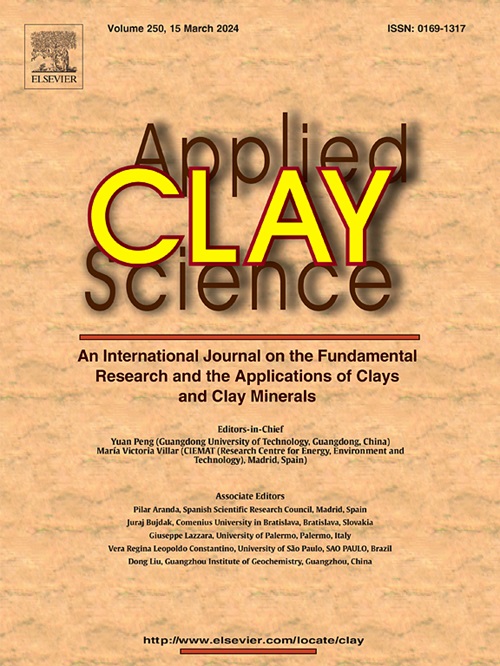高纯度甲基化铁长石纳米管的快速水热和微波合成
IF 5.3
2区 地球科学
Q2 CHEMISTRY, PHYSICAL
引用次数: 0
摘要
为了利用杂种伊莫长石的许多潜在应用,需要一锅可重复的快速合成路线。然而,目前的方案是耗时的,需要加热几天到90°C左右的温度,并且经常导致混浊的溶液。在这里,在更高的温度下开发了一种新的合成方法,可以在几个小时内产生更纯净的纳米管分散体。在这项工作中,我们使用传统的电阻炉或微波炉将反应温度从90°C提高到150°C甚至200°C。利用FTIR光谱、SAXS、XRD、uv -可见光谱和TEM显微镜等多种表征技术对不同热处理时间后得到的悬浮液进行了表征,结果表明,在150℃下3 h和200℃下1 h可以得到高纯度的透明甲基-imogolite悬浮液。我们还证明了纳米管是在有限的时间窗口内获得的中间物质,该时间窗口随温度和加热模式的变化而变化。在低加热时间下,它们的前体亚稳原伊莫长石占优势,而在高加热时间下,伊莫长石分解形成氢氧化铝。在相应的时间窗内增加温度会导致纳米管长度的增加。本文章由计算机程序翻译,如有差异,请以英文原文为准。
Fast hydrothermal and microwave synthesis of high purity methylated imogolite nanotubes
To take advantage of the many potential applications of hybrid imogolites, a one-pot reproducible and fast synthesis route is desirable. However, the current protocols are time consuming, necessitating heating for several days to temperatures of around 90 °C, and often lead to turbid solutions. Here, a new synthesis is developed at higher temperature that produces a purer nanotube dispersion within a few hours. In this work, we increased the reaction temperature from 90 °C to 150 °C and even 200 °C, using either a conventional resistive oven or a microwave. Characterization of the suspensions obtained after different thermal treatment durations using several characterization techniques, including FTIR spectroscopy, SAXS, XRD, UV–visible spectroscopy and TEM microscopy, we show that high purity limpid methyl-imogolite suspensions can be obtained within 3 h at 150 °C and 1 h at 200 °C. We also evidence that nanotubes are intermediate species that are obtained in a limited time window that varies with temperature and heating mode. At low heating duration, their precursor, metastable proto-imogolite, is predominant while at high heating duration, imogolite decomposes to form aluminum hydroxides. Increasing the temperature within the corresponding time window results in an increase of the nanotube length.
求助全文
通过发布文献求助,成功后即可免费获取论文全文。
去求助
来源期刊

Applied Clay Science
地学-矿物学
CiteScore
10.30
自引率
10.70%
发文量
289
审稿时长
39 days
期刊介绍:
Applied Clay Science aims to be an international journal attracting high quality scientific papers on clays and clay minerals, including research papers, reviews, and technical notes. The journal covers typical subjects of Fundamental and Applied Clay Science such as:
• Synthesis and purification
• Structural, crystallographic and mineralogical properties of clays and clay minerals
• Thermal properties of clays and clay minerals
• Physico-chemical properties including i) surface and interface properties; ii) thermodynamic properties; iii) mechanical properties
• Interaction with water, with polar and apolar molecules
• Colloidal properties and rheology
• Adsorption, Intercalation, Ionic exchange
• Genesis and deposits of clay minerals
• Geology and geochemistry of clays
• Modification of clays and clay minerals properties by thermal and physical treatments
• Modification by chemical treatments with organic and inorganic molecules(organoclays, pillared clays)
• Modification by biological microorganisms. etc...
 求助内容:
求助内容: 应助结果提醒方式:
应助结果提醒方式:


